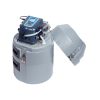Hach IO9000 I/O Modules
Features
- Digital outputs can be used to indicate an alarm or an event
- Analog 0/4-20 mA outputs can be used to send information to a SCADA system
- Analog 0/4-20mA inputs can be used to interface third party sensors to the AS950
- Free ground shipping
- Expedited repair and warranty service
- Lifetime technical support
- More
Maximum Versatility
The IO9000 module allows the use of analog inputs and outputs with the AS950 sampler. With the IO9000 module, the AS950 provides more input and output options than any other Hach sampler before it. For added versatility the IO9000 is available in two versions; IO9001 is available for simple applications that only require 1 high voltage relay while the IO9004 is fully loaded. See specifications for more detail.
Outputs
Analog 0/4-20 mA outputs can be used to send information to a SCADA system for parameters such as level, velocity, flow and pH. Examples of alarms and events include: sensor outside of limits (flow related, water quality related, internal temperature or ambient temperature), program started, program completed, sample being taken, bottle full (single bottle), pump running forward, pump running in reverse, pump error, distributor error, power failure, or main battery low.
Inputs
Analog 0/4-20mA inputs can be used to interface third party sensors to the AS950. Once logged, the analog process measurement can be used like a Hach sensor in applications such as setpoint alarms or event-based sampling. In addition, the third party measurements can be monitored on the user interface along with Hach sensors and peripherals.
Relays
Like the digital outputs, these relay outputs are used to indicate alarms or events. The difference is that relays can be used for switching AC mains line voltage to control higher power functions. Examples for use are for a warning light or sound signal, switching a diversion valve or gate or a control signal to another machine.
In The News
Monitoring Meadowbrook Creek: Real-Time Data Collection in an Urban Creek
Meadowbrook Creek in Syracuse, New York, has been monitored by Syracuse University (SU) faculty and students for over a decade. Originally established by Dr. Laura Lautz in 2012, the early years of the program focused on collecting grab water samples for laboratory analysis and evaluating the impact of urban land use, human activities, and natural processes on water resources. Tao Wen , an Assistant Professor in SU’s Department of Earth and Environmental Sciences, took over the program in 2020 and upgraded the existing systems to include 4G modems that allowed for real-time data viewing. [caption id="attachment_39339" align="alignnone" width="940"] An overview of the Fellows Ave monitoring station along Meadowbrook Creek.
Read MoreLancaster County Makes the Switch to Real-Time Water Quality Monitoring Systems
Continuous data collection in Lancaster County, Pennsylvania, started about 5 years ago, and the county will be making a major upgrade over the next year—switching from relying solely on the internal storage of water quality sondes to telemetry units that enable real-time data viewing. [caption id="attachment_39295" align="alignnone" width="940"] The first telemetry unit was installed at LCCD along Little Conestoga Creek. (Credit: Tyler Keefer / LCCD) [/caption] Telling Lancaster County's Story Through Data Since the Lancaster County Conservation District started monitoring county waterways, the goal has remained the same, according to Amanda Goldsmith, Watershed Specialist for the Watershed Department.
Read MoreFrom Florida to the World: How a Smithsonian Research Station is Bridging Gaps in Marine Biology
In the early 2000s, along the coast of northern California, where the redwoods dominate the forests, and the Pacific Ocean shapes shorelines, a Humboldt University undergraduate student took the first steps into a lifelong love of marine biology. Dean Janiak accepted an invitation to help a graduate student with fieldwork in rocky coastal tide pools, and so began a journey that led him from California to Connecticut to Florida and eventually to the world, where he has facilitated research in communities across the globe. While finishing up his masters of Oceanography from the University of Connecticut, Janiak continued researching fouling communities–marine life that live on hard, often artificial surfaces such as docks–at the Smithsonian Environmental Research Center.
Read More








